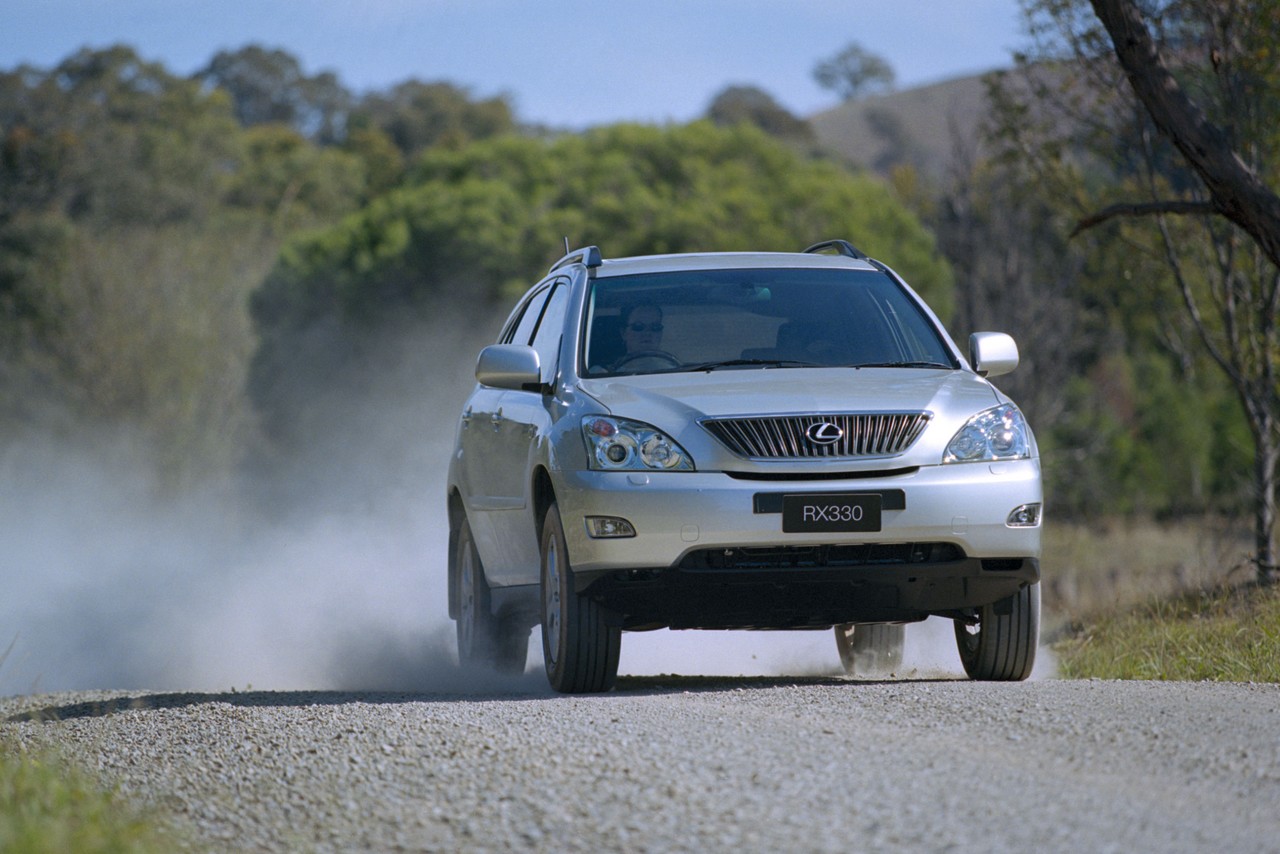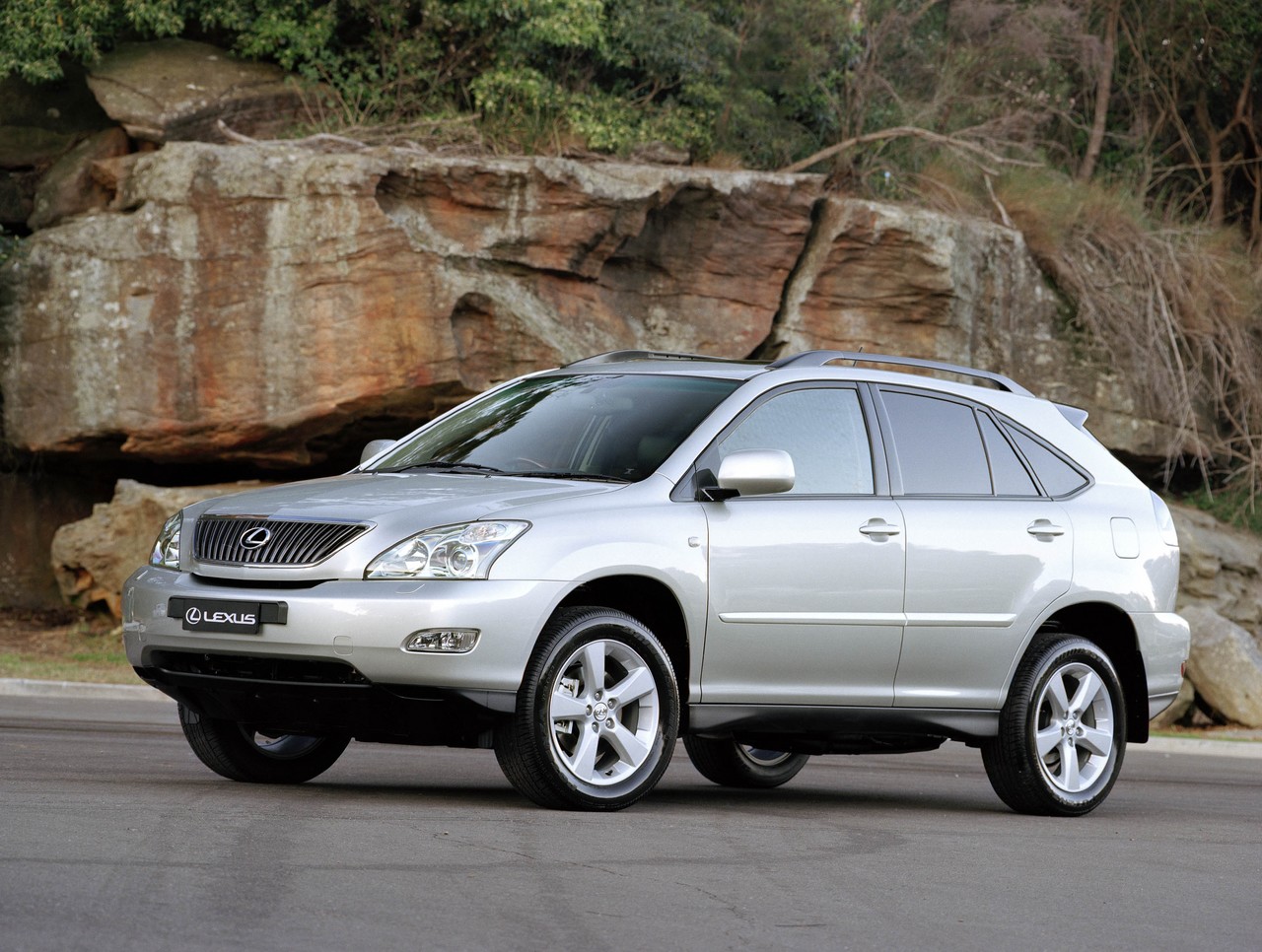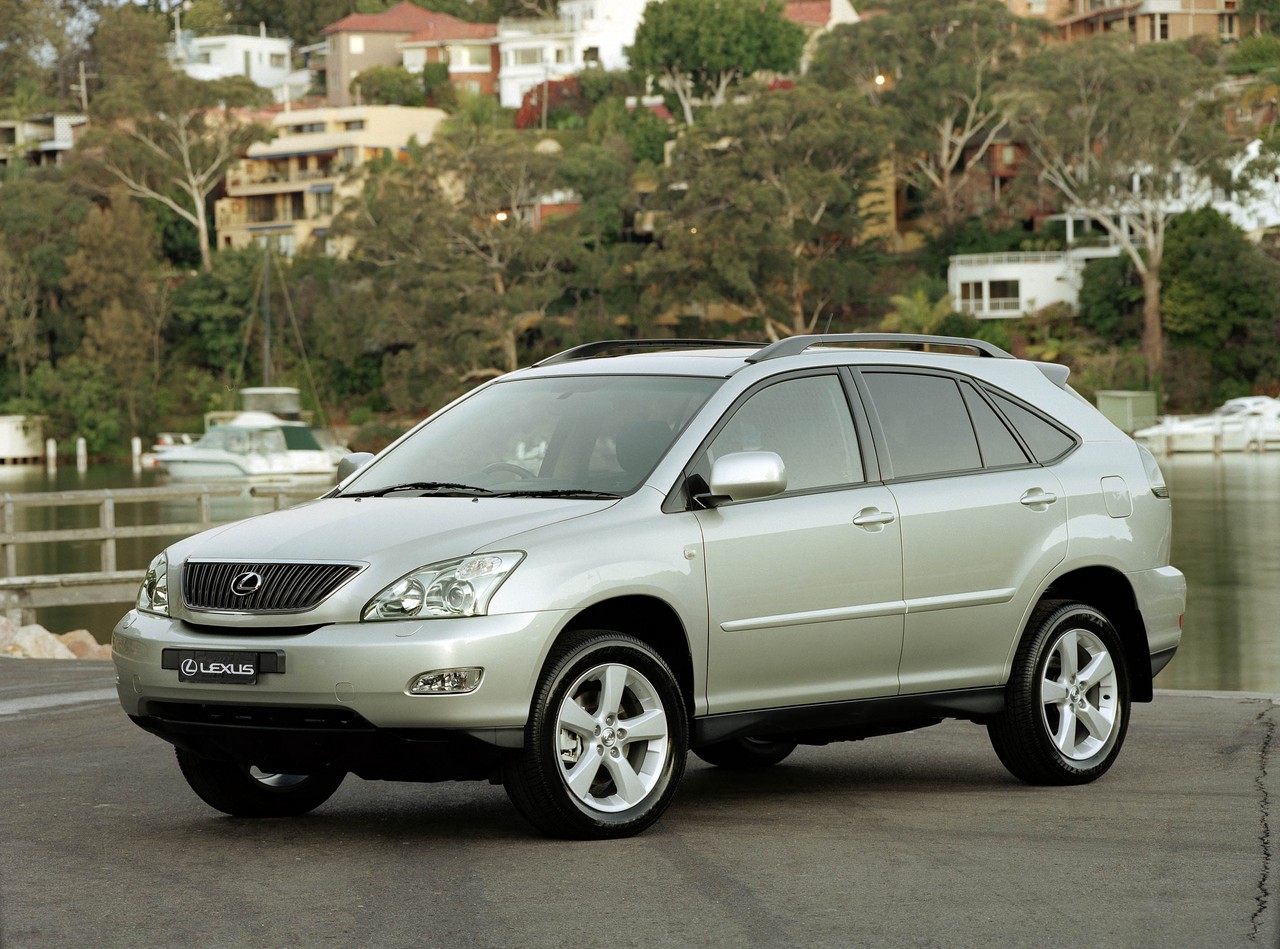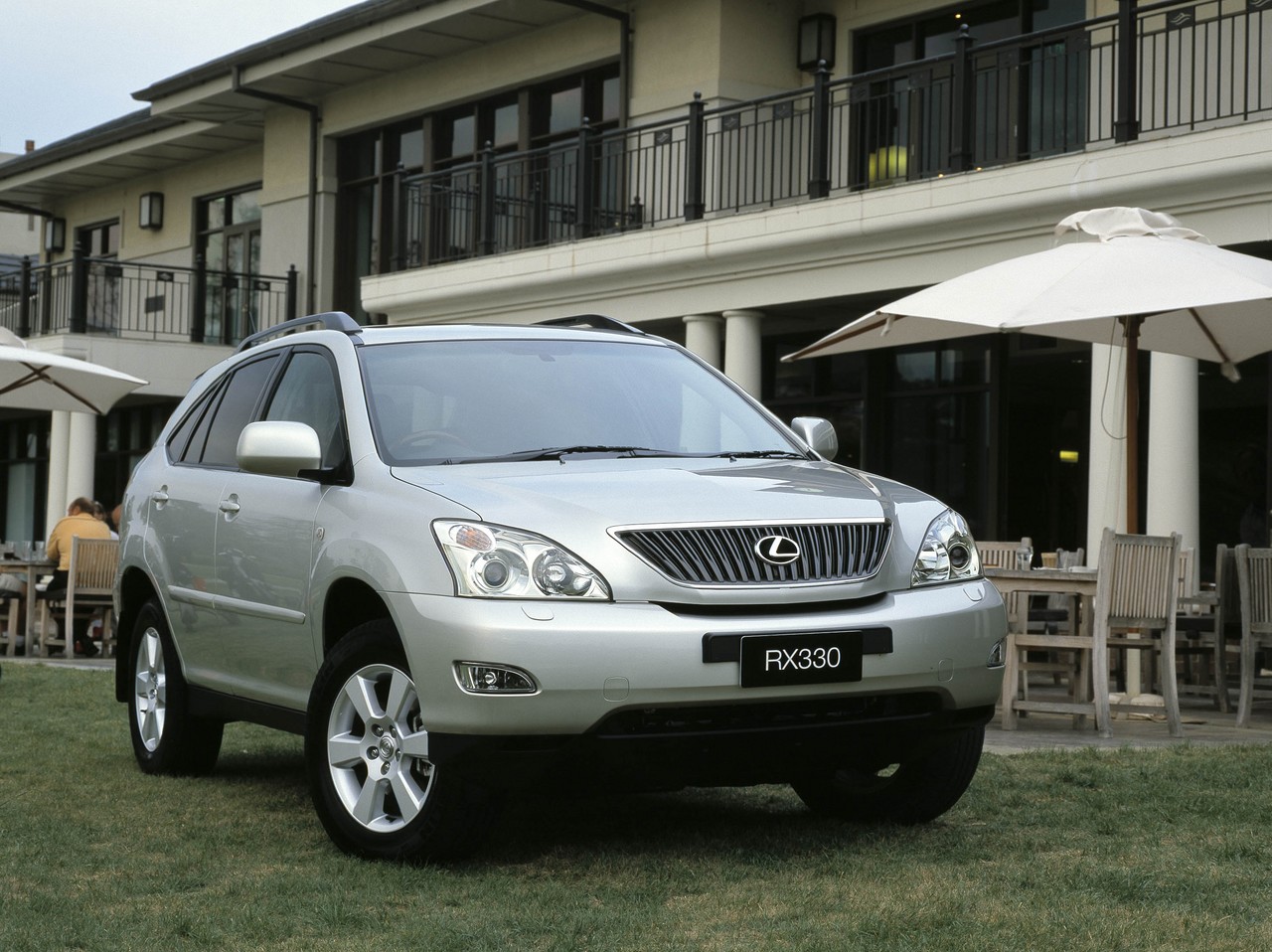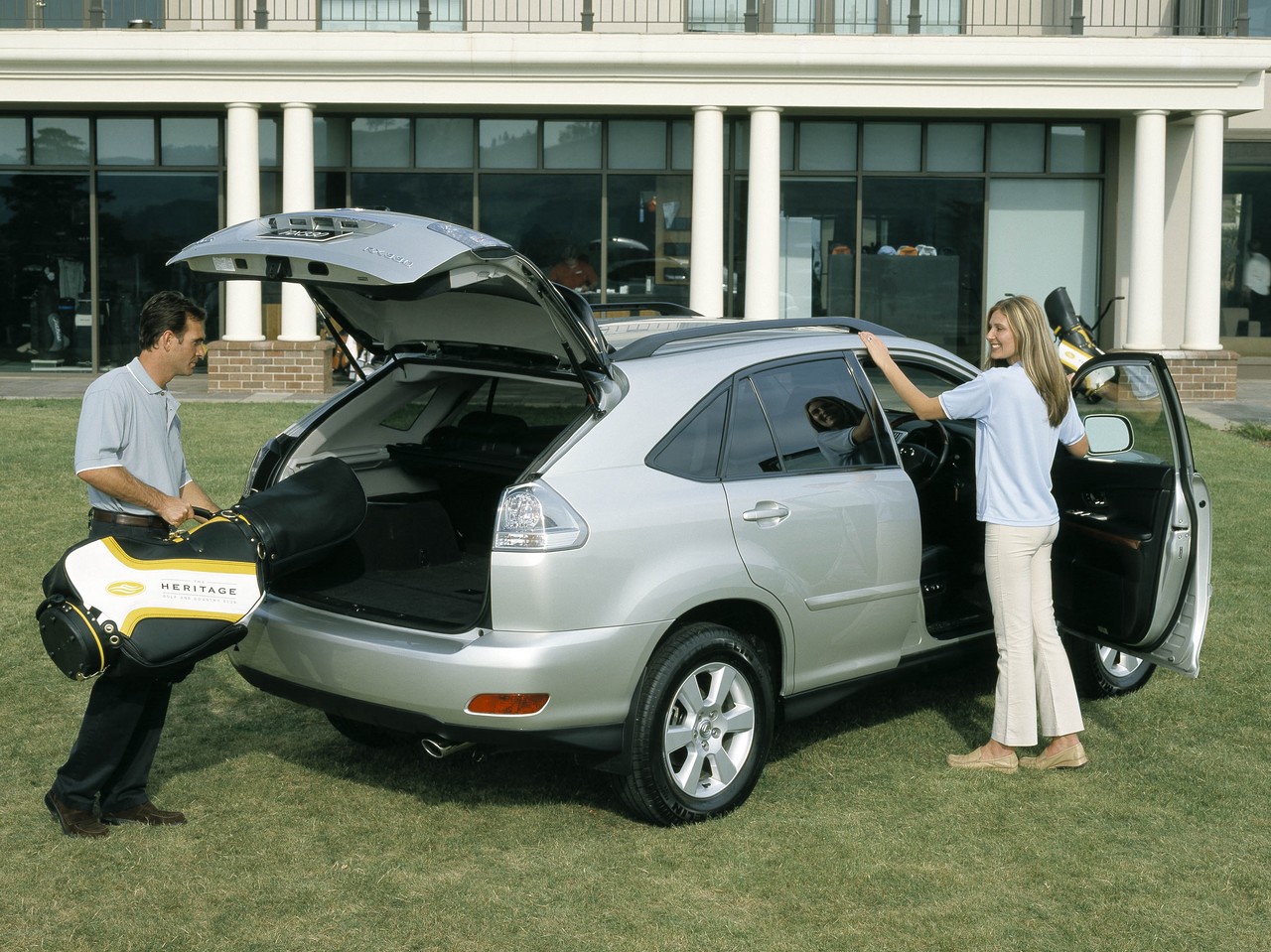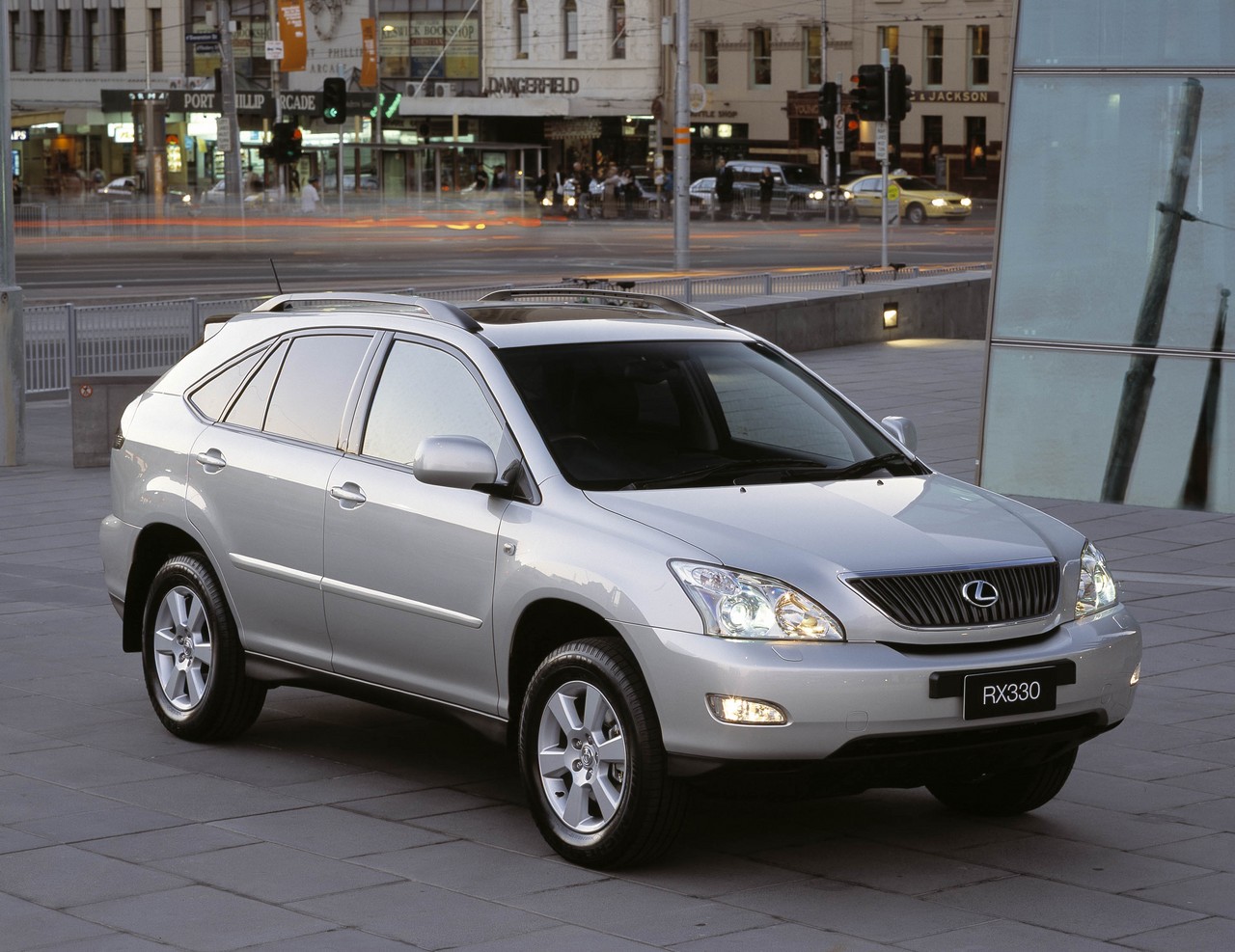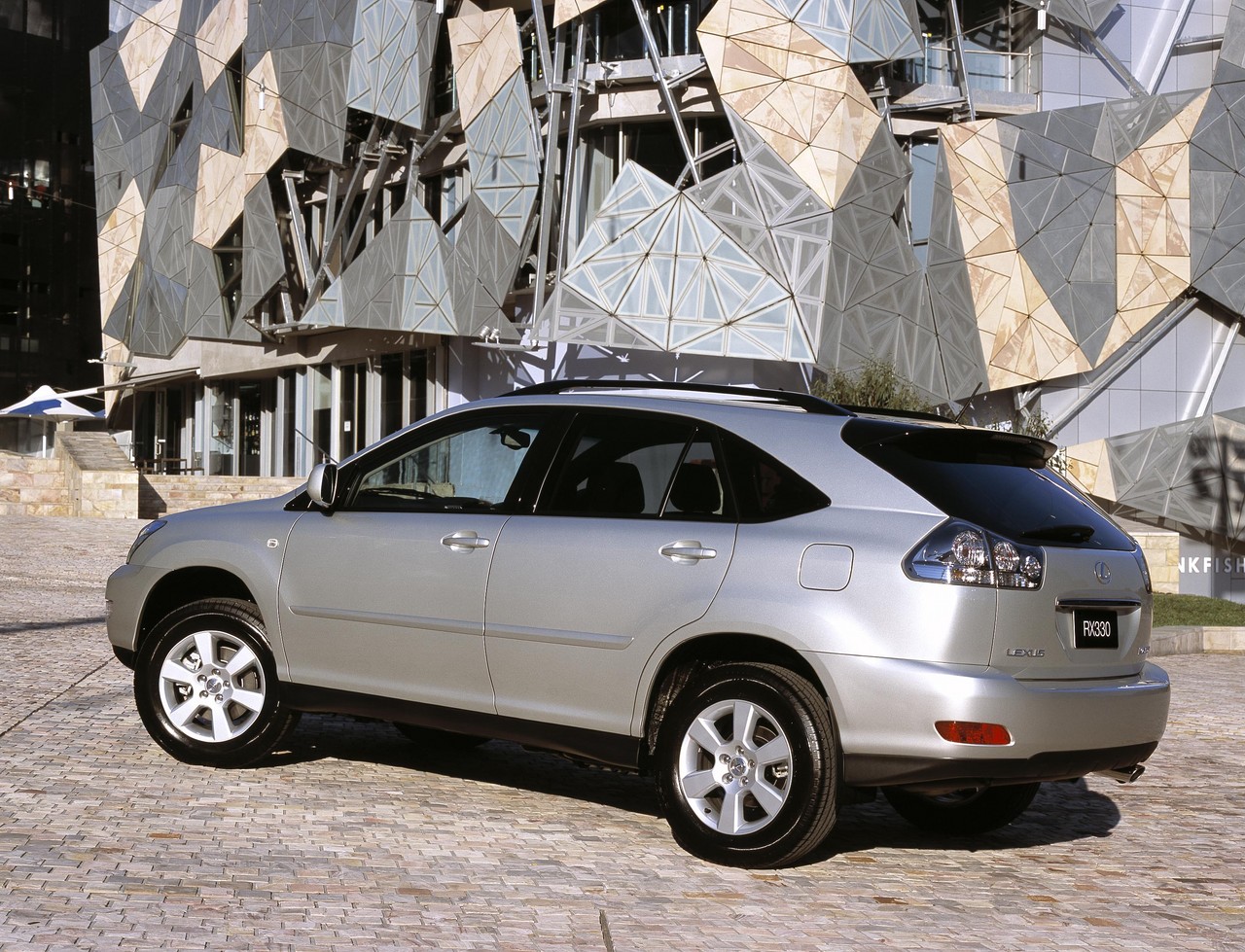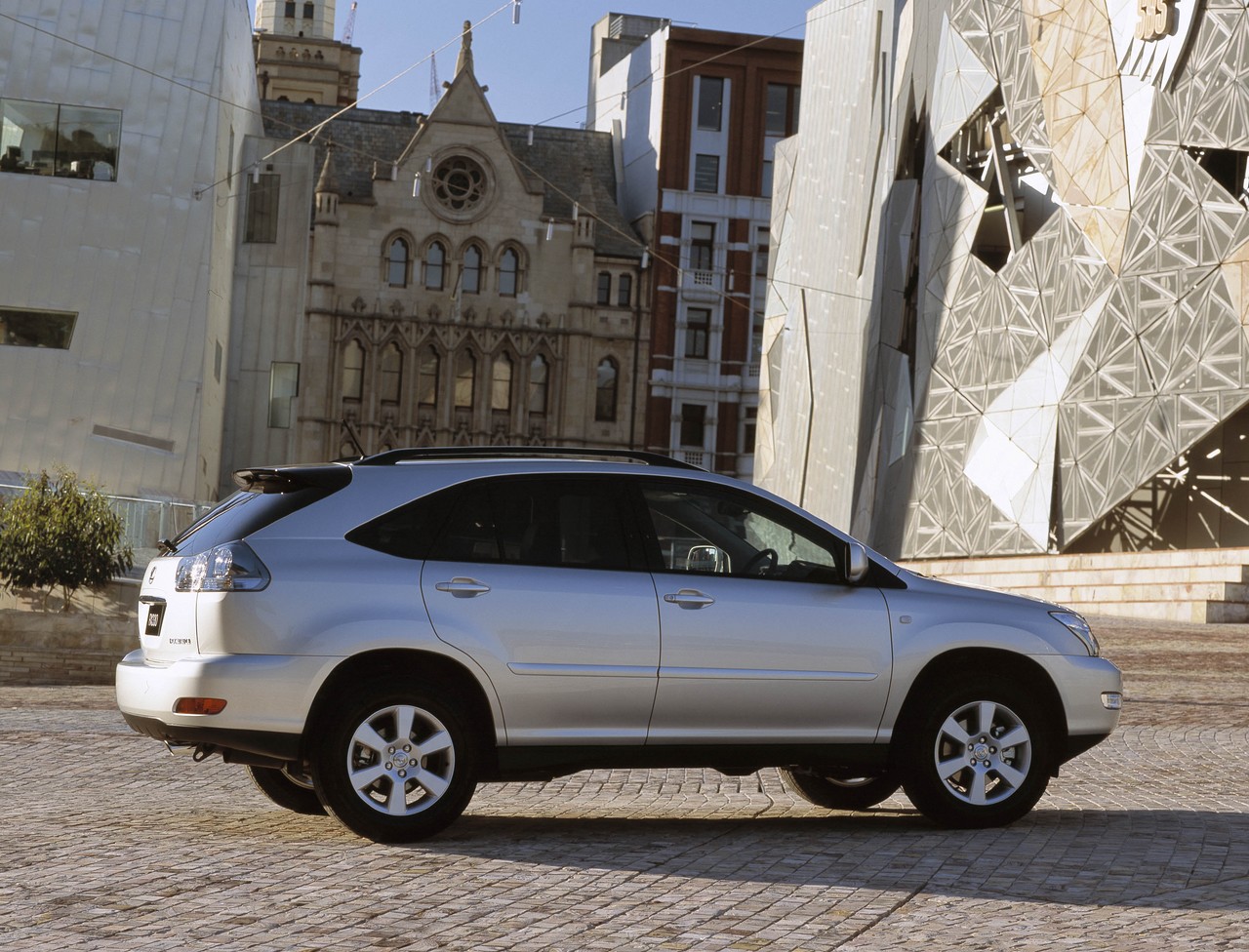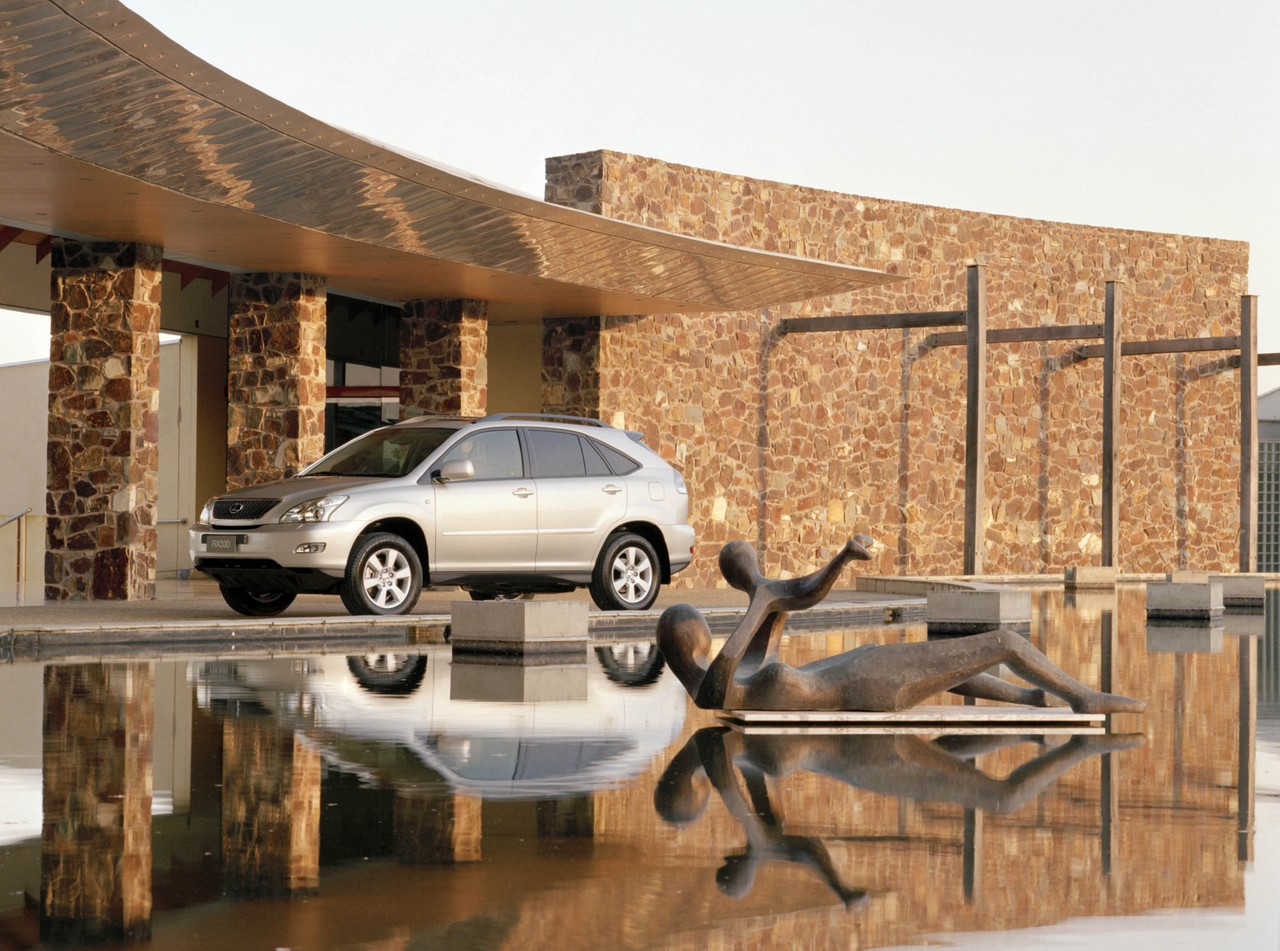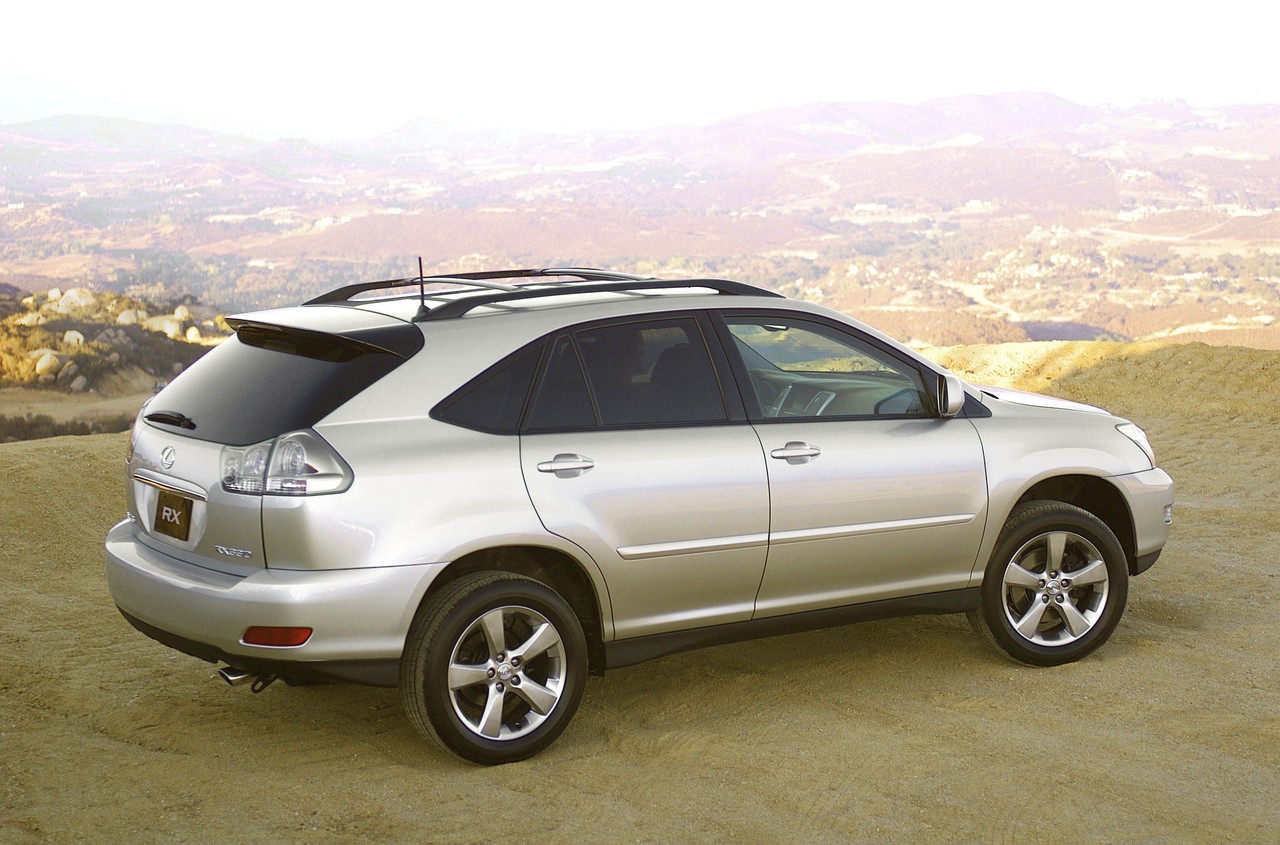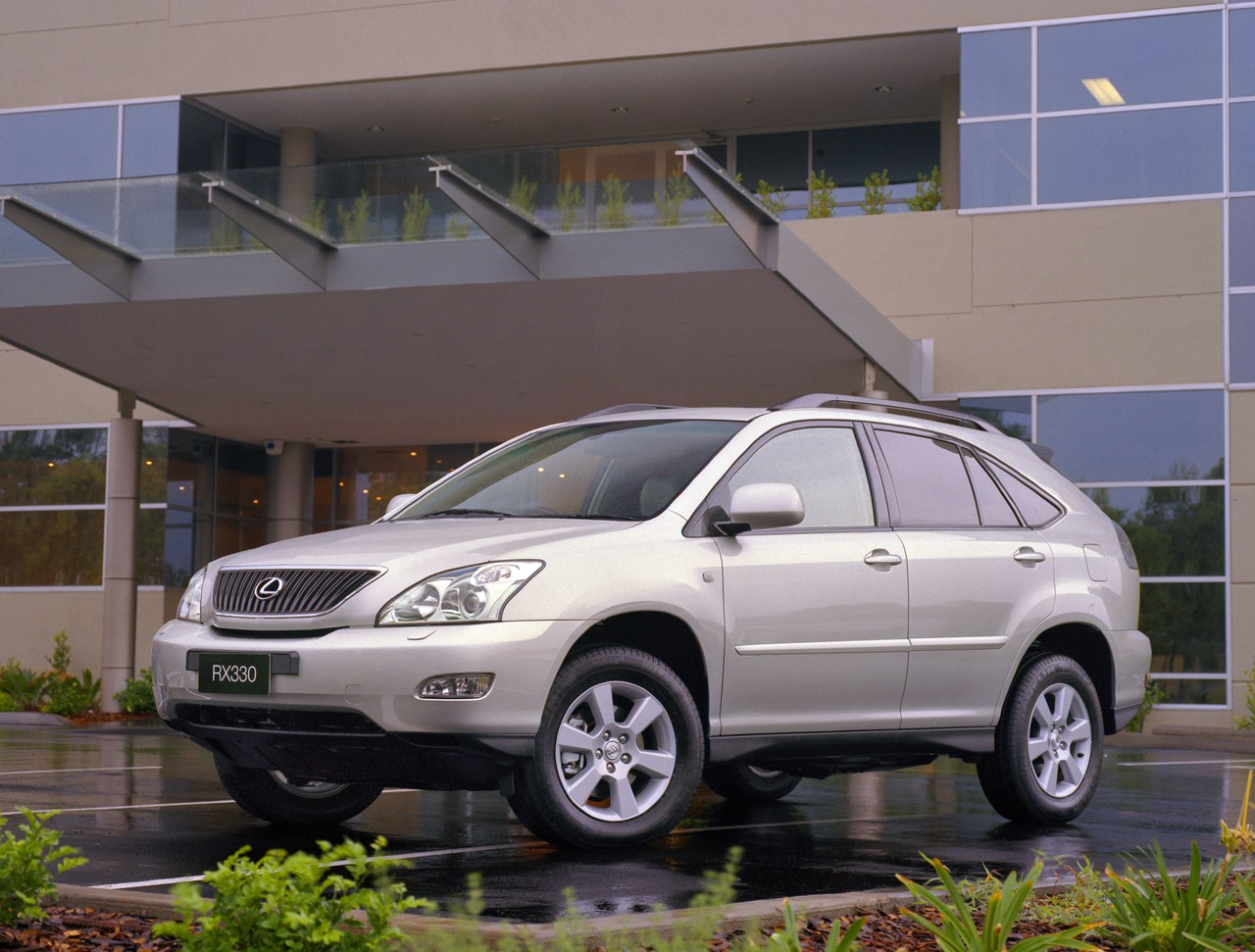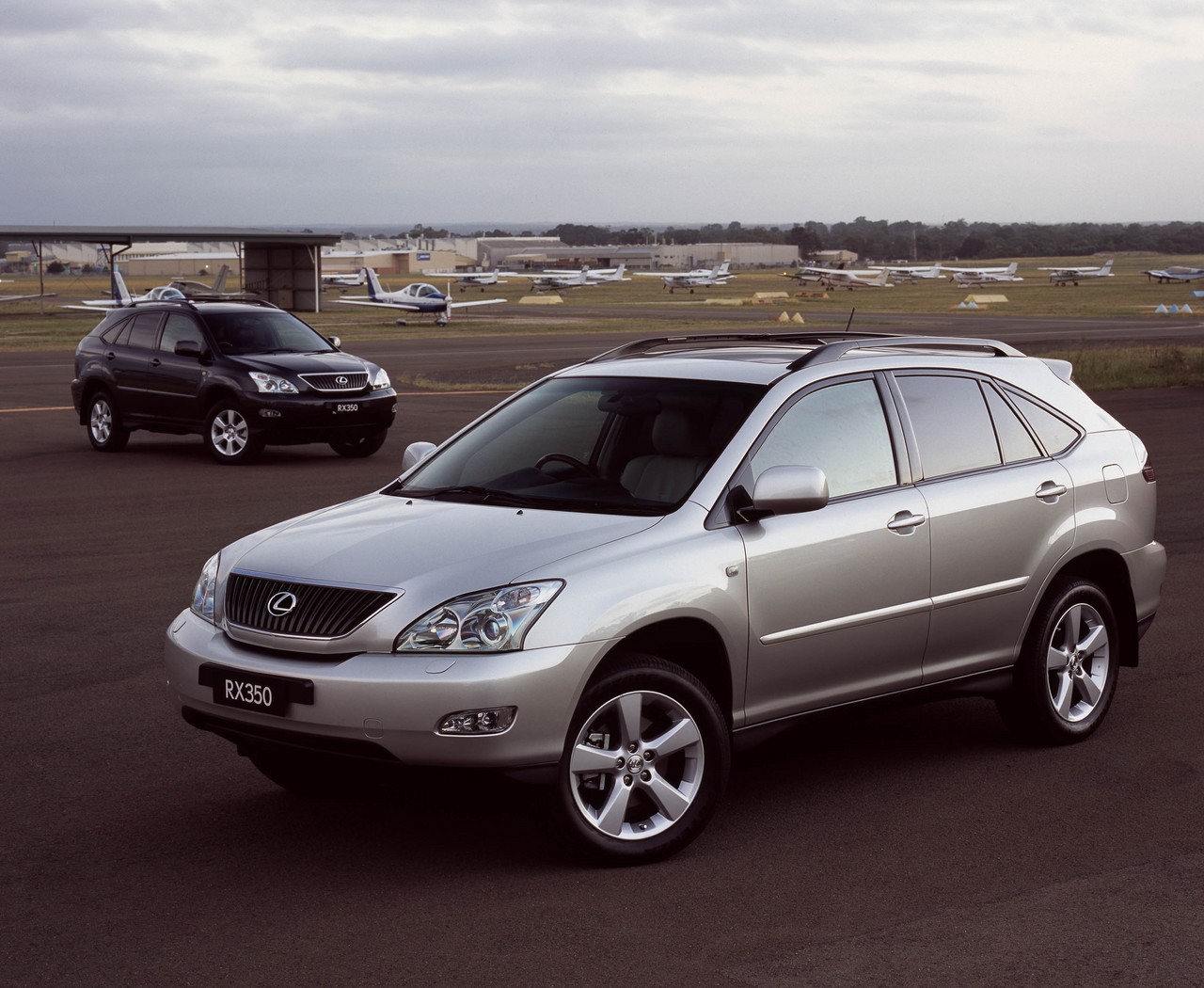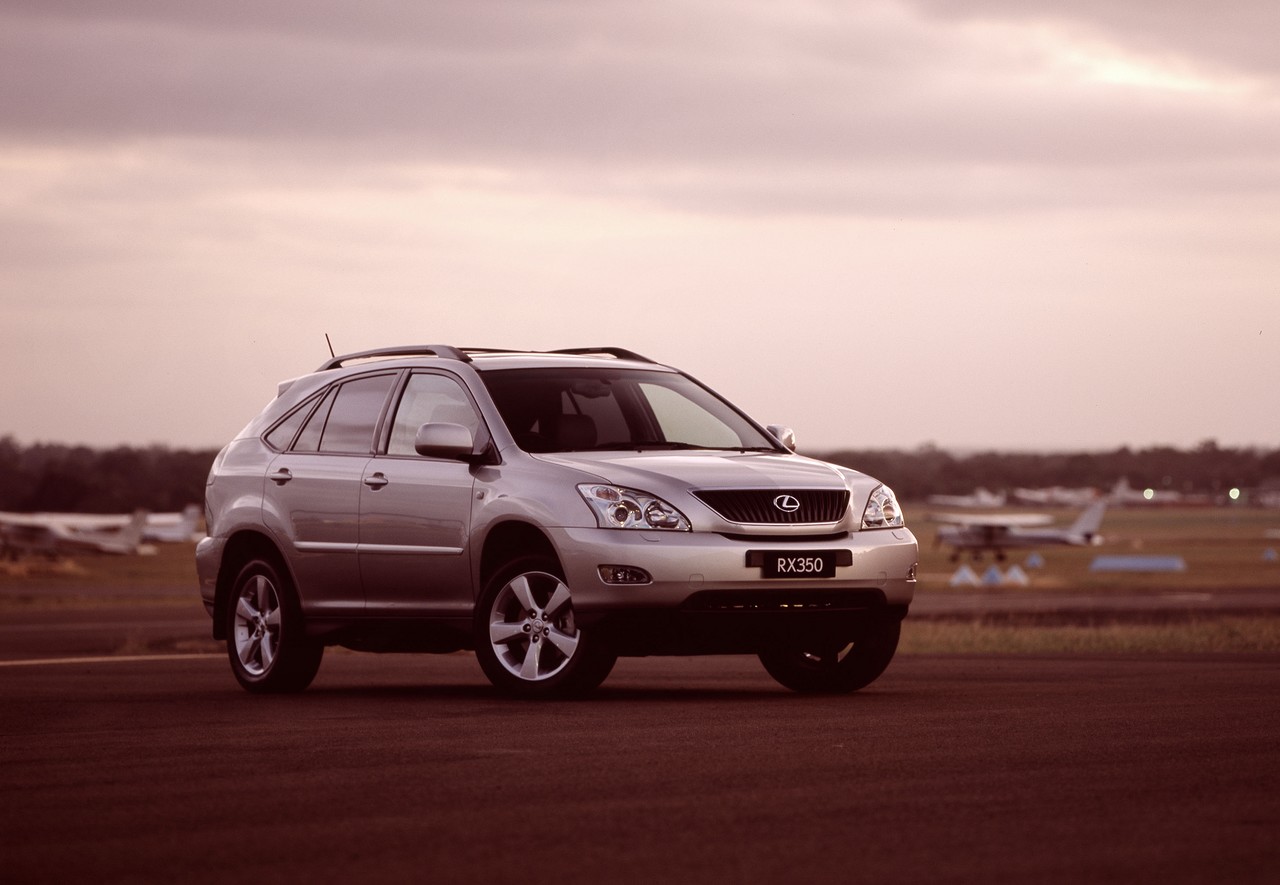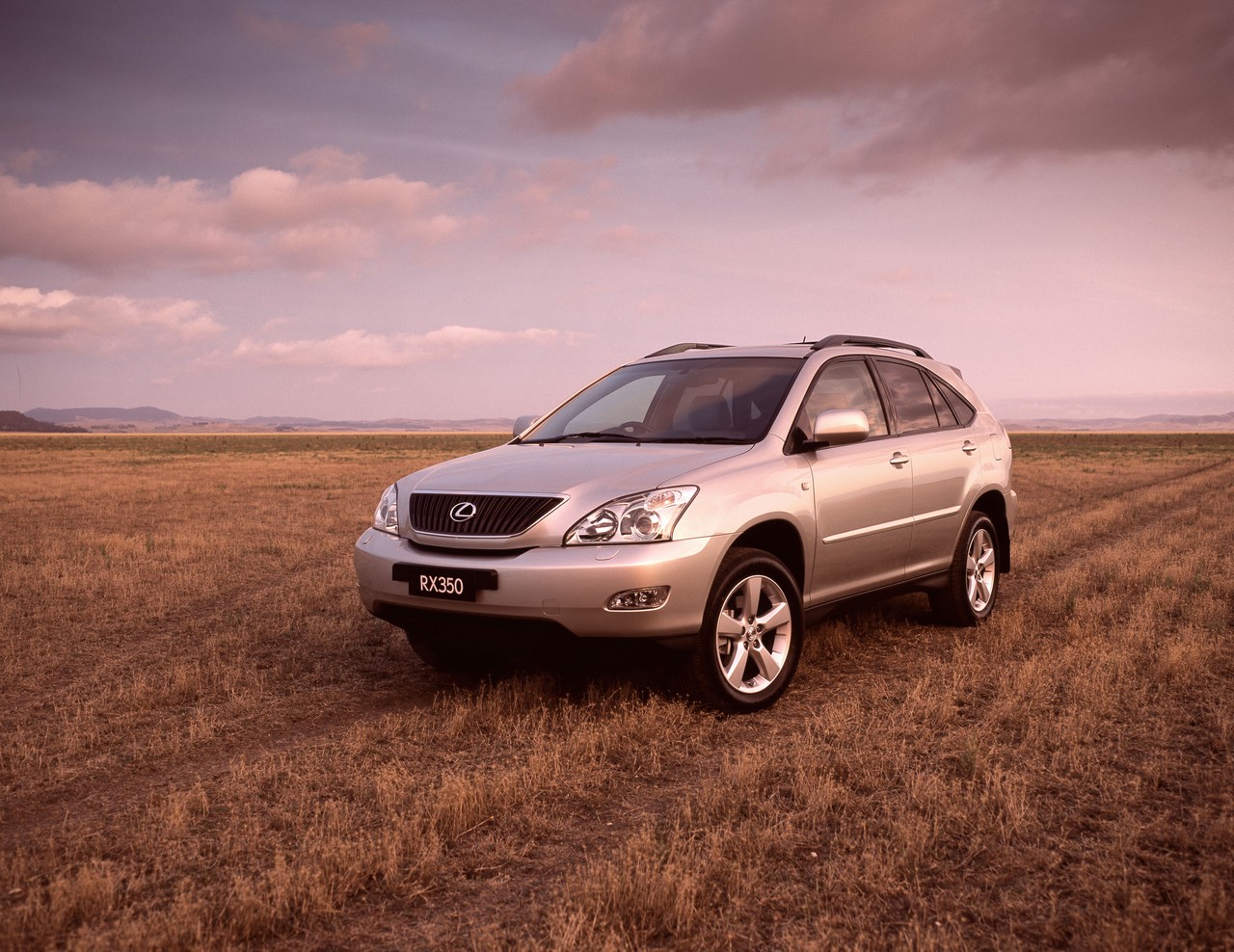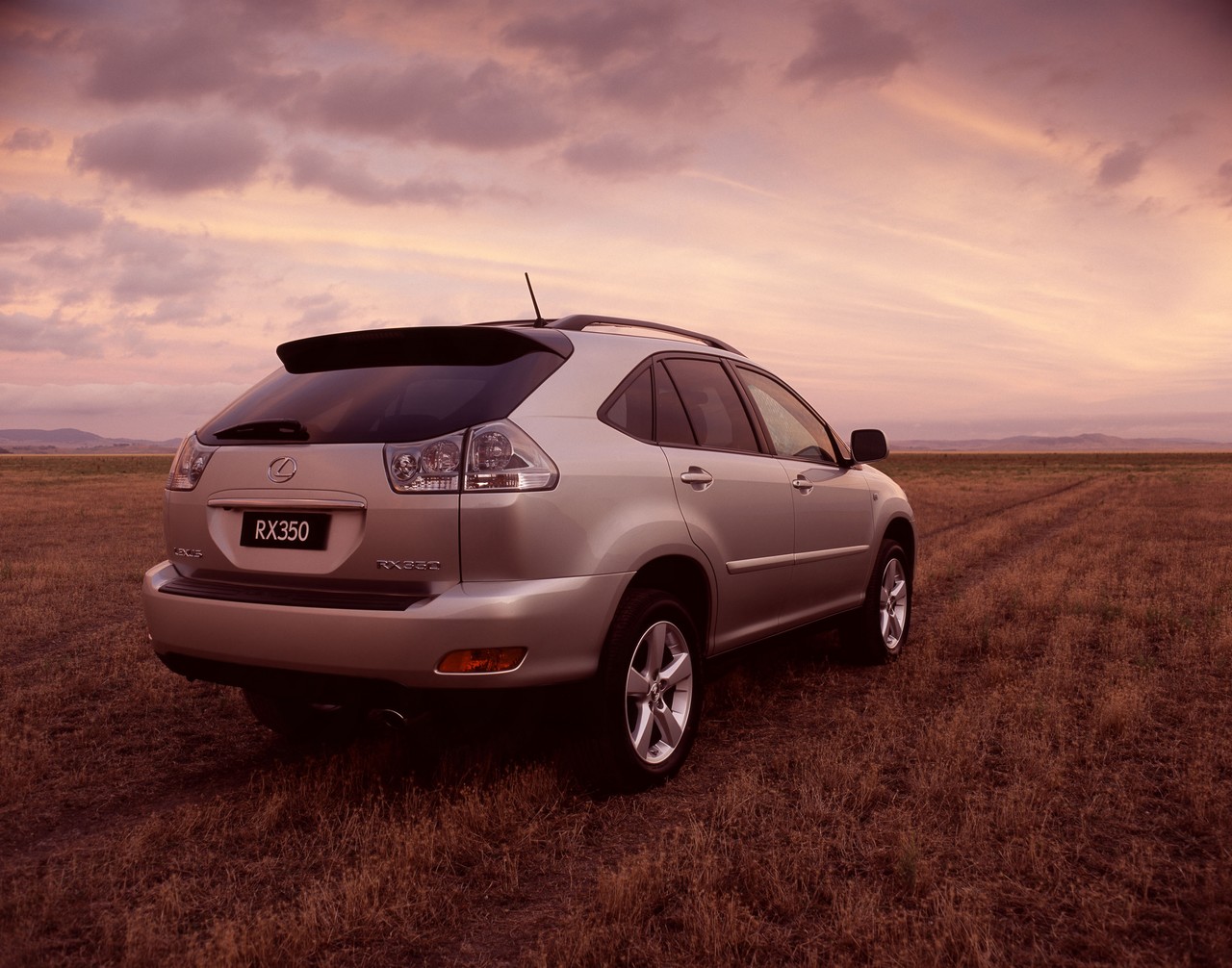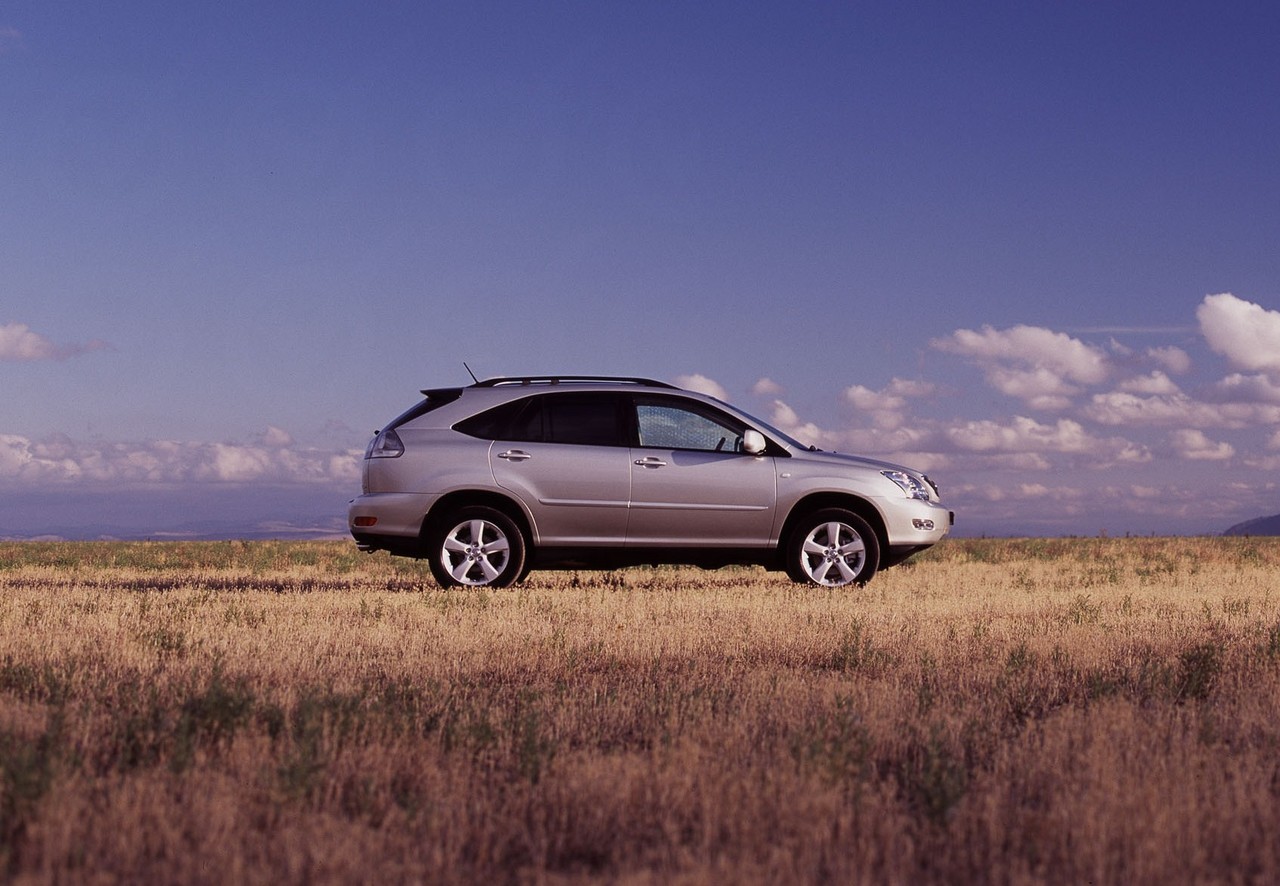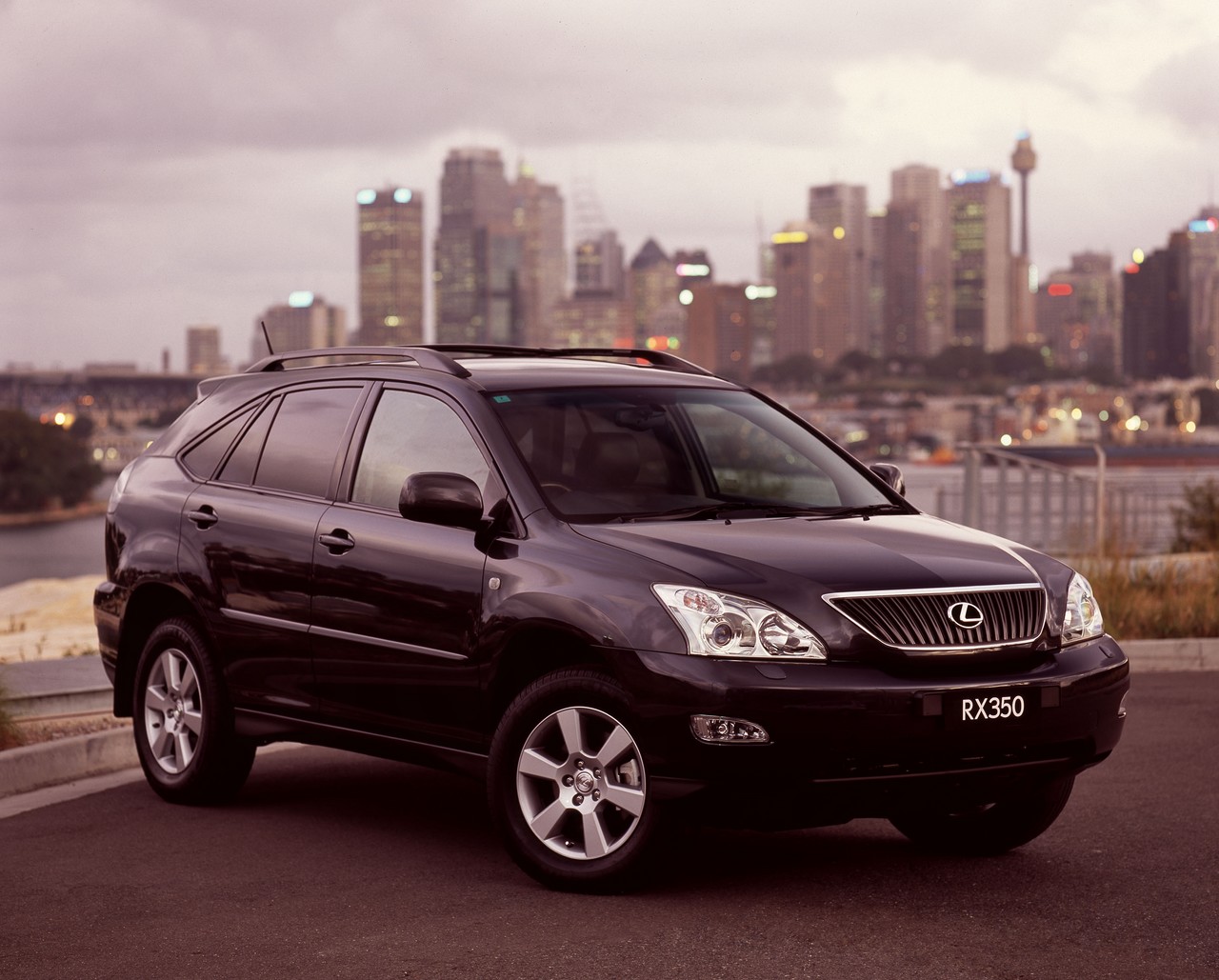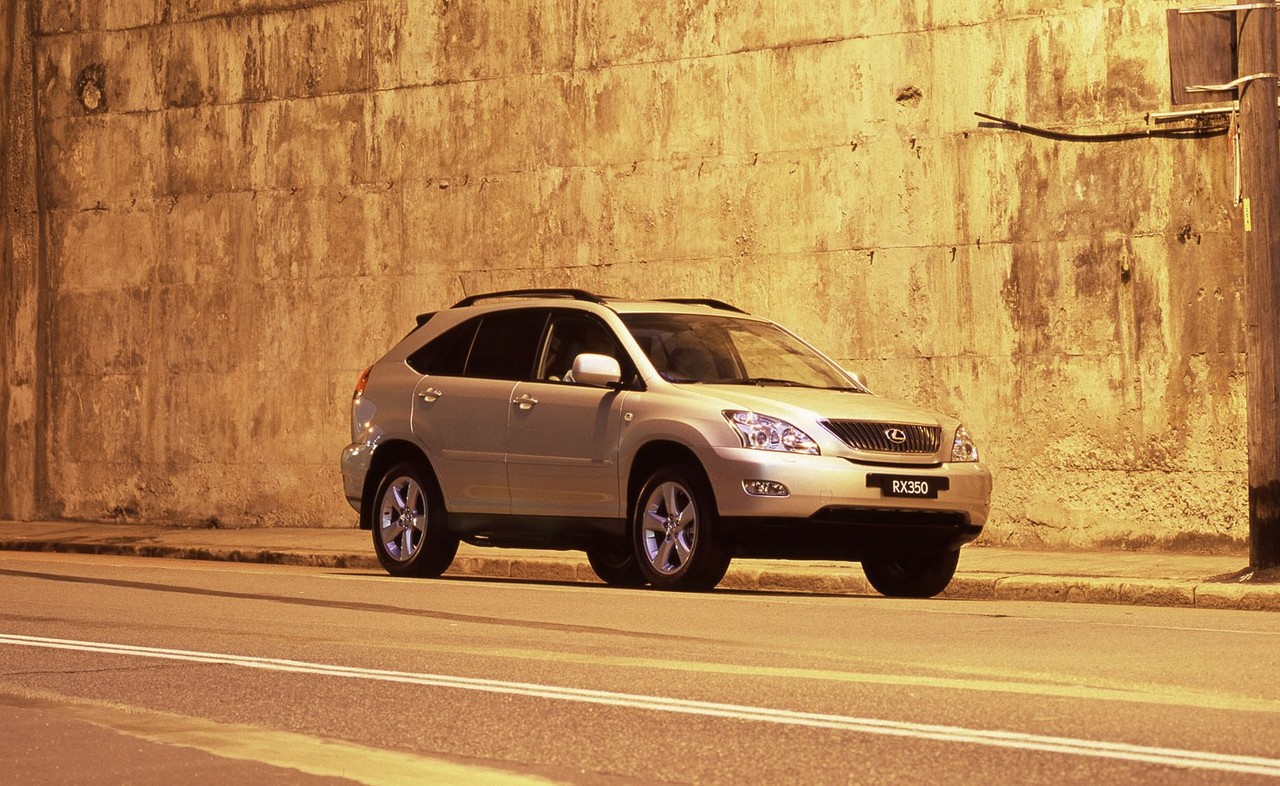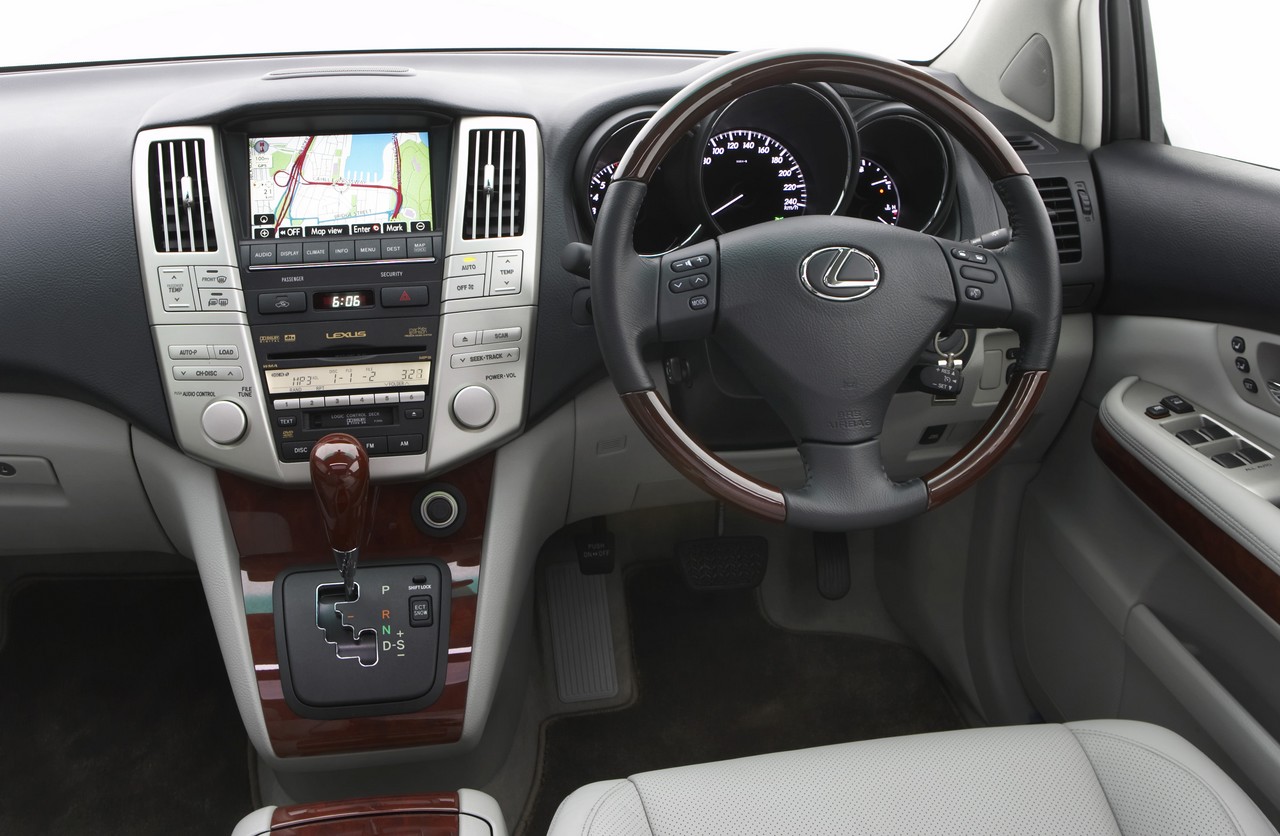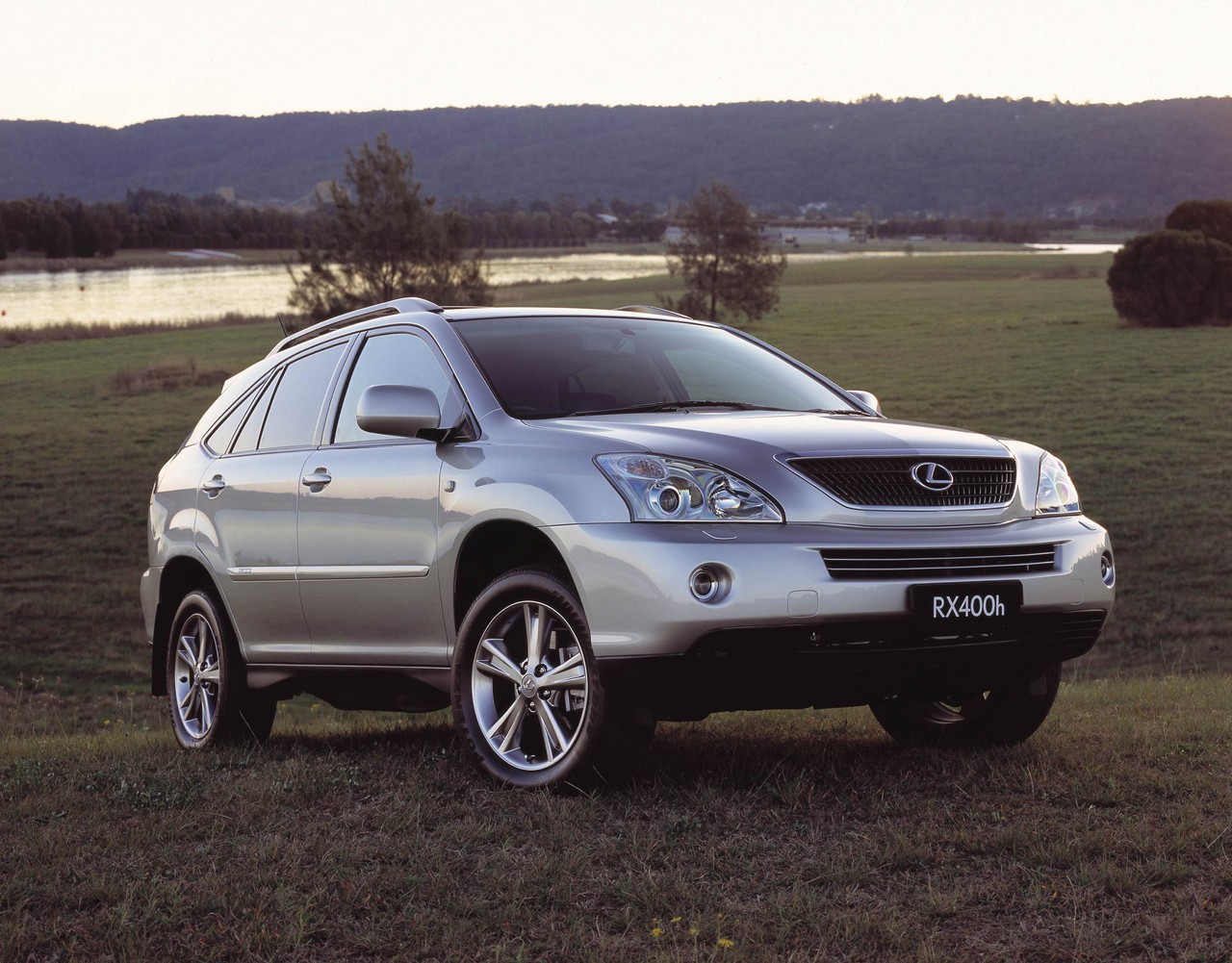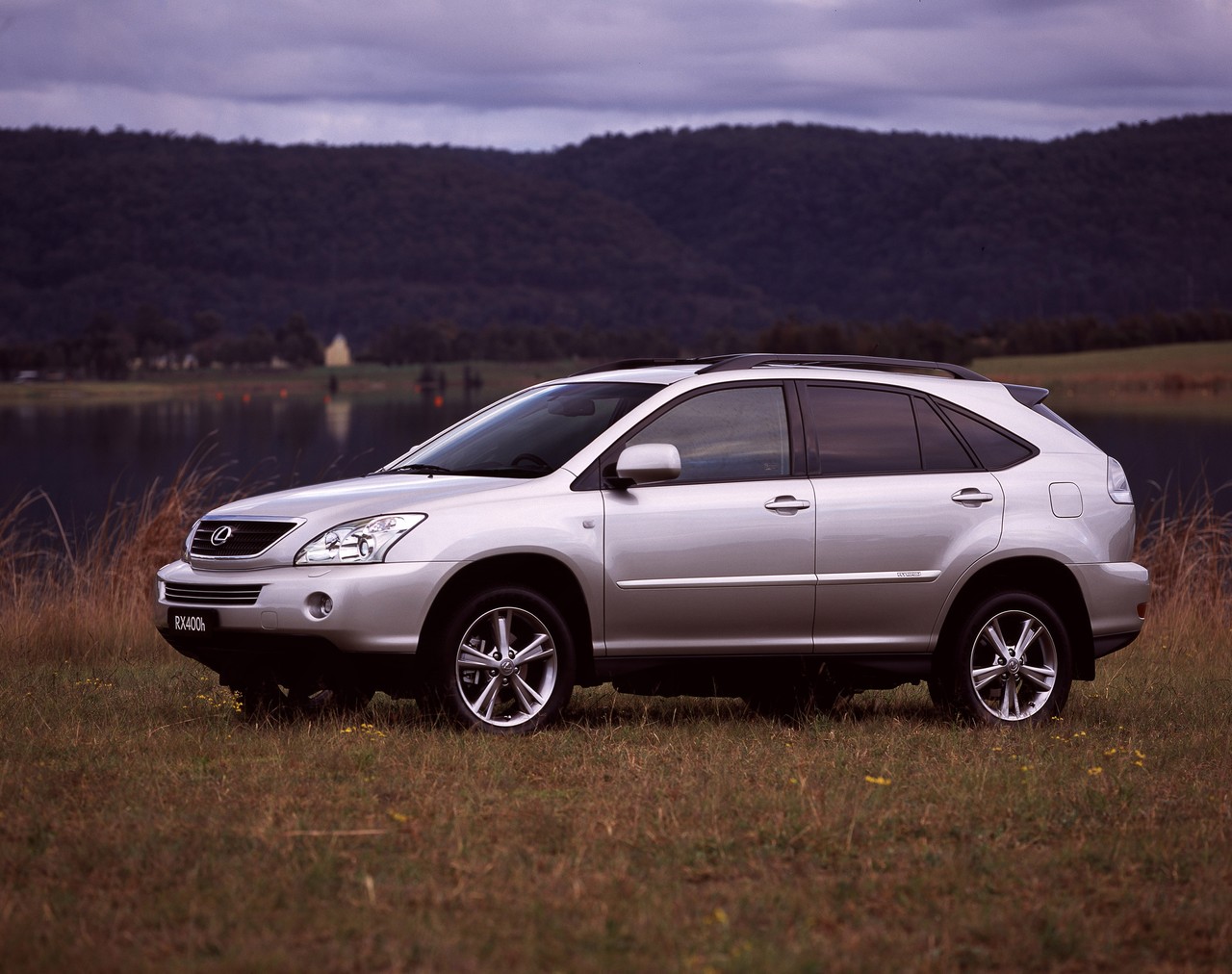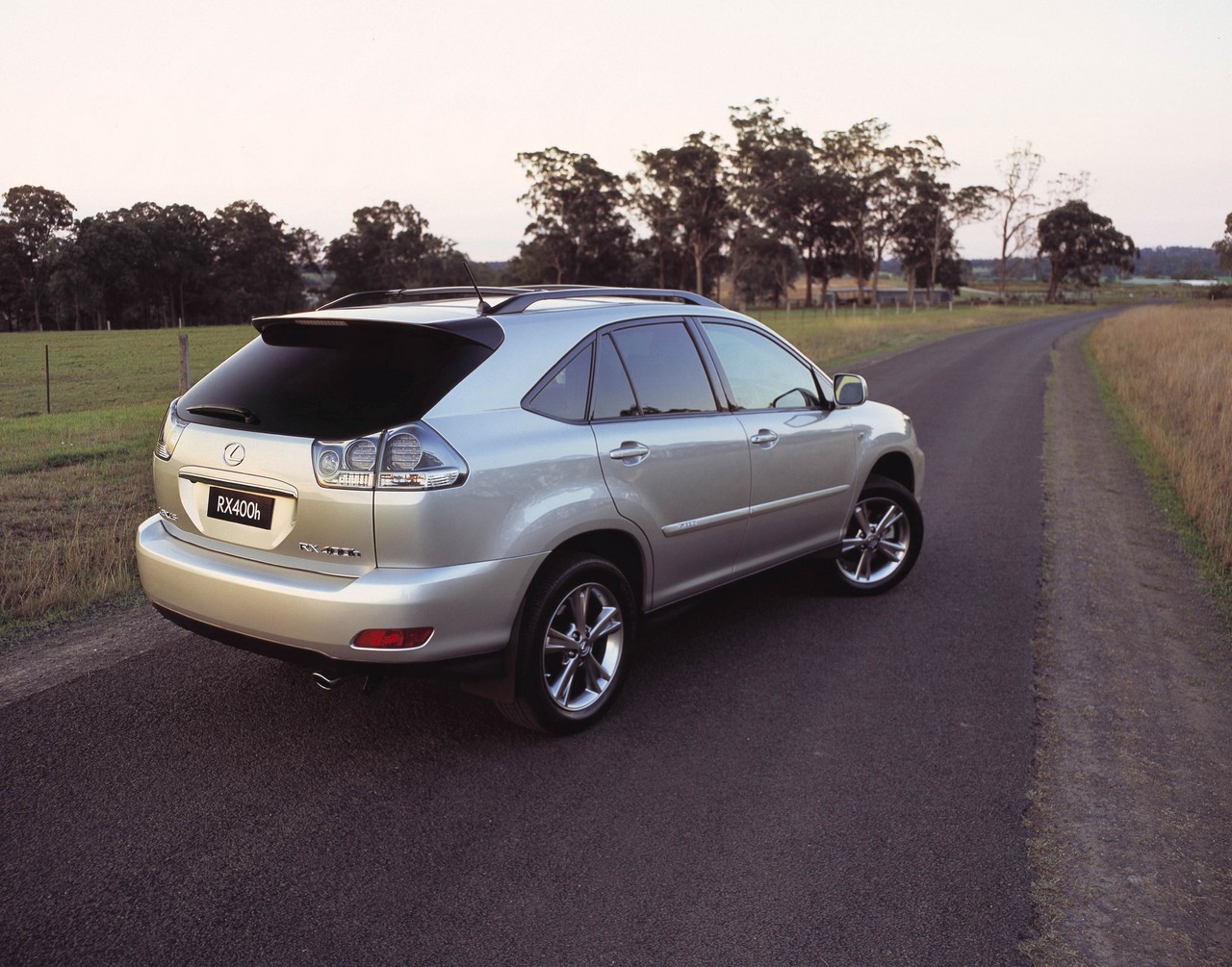
- Refined powertrains
- Comfortable seats
- Excellent ride quality
- Quiet, well-insulated cabin
- High quality interior fit and finish
- Performance of RX 330 only adequate
- ESC programming struggles with loose surfaces like dirt
- Limited off-road ability
Review: Lexus XU30.I RX 330 (2003-05)
Overview
Released in April 2003, the Lexus XU30 Series I (XU30.I) RX was a four-wheel drive SUV. Manufactured in Miyawaka, Japan, the XU30.I RX range consisted of a single model – the RX 330 – which was powered by a 3.3-litre V6 petrol engine that was mated to a five-speed automatic transmission. Furthermore, the RX 330 was available in Sports and Sports Luxury variants.
3MZ-FE engine
The 3.3-litre 3MZ-FE V6 engine had an aluminium block and heads, six-bolt main bearing caps, an acoustically controlled variable induction system, double overhead camshafts (per cylinder bank), four valves per cylinder, variable intake valve timing (VVT-i) and a compression ratio of 10.8:1.
Over the combined ADR 79/00 cycle, fuel consumption was 12.3 litres per 100 km.
Dimensions and body
The XU30 RX was 4740 mm long, 1845 mm wider, 1720 mm high and its wheelbase was 2715 mm long; the body itself had a coefficient of drag of 0.36 Cd. Inside, the RX 330 had 40/20/40 split and folding rear seats, sliding rear seats and a sliding centre console. With the rear seats in position, cargo capacity was 423 litres (VDA method), though this increased to 2054 litres when the seats were folded down.
Suspension
The XU30 RX had MacPherson strut front suspension with L-shaped lower arms and independent rear suspension with dual links.
| Model | Variants | Engine | Trans. | Peak power | Peak torque |
|---|---|---|---|---|---|
| RX 330 | Sports, Sports Luxury |
3.3-litre petrol V6 (3MZ-FE) | 5sp auto | 172 kW at 5600 rpm | 328 Nm at 3600 rpm |
4WD system
The RX 330 had a permanent four-wheel-drive system with an electronically-controlled centre differential. In normal conditions, the system provided a 50:50 front:rear torque split, though torque could be redirected if traction was lost via the traction control system.
Safety equipment
Standard safety equipment for the RX 330 included dual front airbags, front side airbags, full length curtain airbags (i.e. for front and rear occupants), a driver’s knee airbag, ABS, electronic brake force distribution, brake assist, electronic stability control, traction control and front seatbelts with pretensioners and load limiters.
Brakes
The RX 330 had 319 mm by 28 mm ventilated front brake discs with single piston floating calipers and 288 mm by 10 mm solid rear discs with single piston floating calipers.
Features: RX 330 Sports and Sports Luxury
Standard features for the RX 330 Sports included 17-inch alloy wheels with 225/65 R17 Michelin tyres, an eight speaker sound system with a six-stack CD player, dual-zone climate control air conditioning, leather seats, cruise control, power adjustable front seats, front and rear fog lamps, xenon headlights, automatic headlights, rain-sensing wipers, remote central locking, power mirrors and windows, automatically dipping door mirrors when reversing, a height and reach adjustable steering wheel, driver memory settings (seat and steering wheel), a 12 volt power outlet, cargo cover, power closing tailgate, roof rails, a trip computer and an immobiliser.
The RX 330 Sports Luxury was further equipped with an eleven speaker, 240 watt Mark Levinson sound system, satellite navigation with touch screen and rear vision camera.
September 2004: RX 330 update
In September 2004, the RX 330 was updated with directional headlights fitted across the range. The Sports Luxury variant was also fitted with 18-inch alloy wheels, Bluetooth connectivity and an updated satellite navigation system.
Related links
- Press Kit: Lexus XU30.I RX 330 (April 2003)
- Press Release: Lexus XU30.I RX 330 – directional headlights (September 2004)
Review: Lexus XU30.II RX 350 and 400h (2006-08)
Overview
Released in March 2006, the XU30 Series II (XU30.II) RX range introduced the RX 350, replacing the RX 330. While the RX 350 was available in Sports and Sports Luxury variants, the RX range was expanded in September 2006 with the introduction of the RX 400h.
RX 350: 2GR-FE engine
For the RX 350, the 3.5-litre 2GR-FE V6 petrol engine had a die-cast aluminium cylinder block, aluminium alloy pistons, double overhead camshafts (per cylinder bank), roller rockers, an electronic Acoustic Control Induction System (ACIS), four valves per cylinder, variable intake and exhaust valve timing (dual VVT-i) and a compression ratio of 10.8:1.
RX 400h: 3MZ-FE engine and electric motors
In September 2006, the RX range was expanded with the introduction of the hybrid RX 400h. Like the RX 330, the RX 400h was powered by a 3.3-litre 3MZ-FE petrol engine , but added two electric motors for the front wheels and another electric motor for the rear wheels. Furthermore, the electric motors drew power from a 288 volt sealed nickel-metal hydride battery which consisted of 240 cells.
When starting, only the electric motors were used though, when more power was required, the generator would start the petrol engine (which would operate in conjunction with the electric motors). After the initial acceleration phase, and under normal driving conditions, the RX 400h would stop the rear electric motor. In low load and constant cruising, power from the petrol engine would be split between the wheels and generator to produce electricity for the electric motors. When the RX 400h was stationary, the petrol engine would switch off to minimise fuel consumption, while the electric motor remained on for immediate start. The RX 400h also had a regenerative braking which captured energy generated when braking to recharge the battery.
RX 400h: all-wheel drive system
While the RX 350 had permanent four-wheel drive, the RX 400h had an all-wheel drive system (‘E-Four’) as the rear wheels were driven exclusively by an electric motor. As such, the skid-control computer calculated the optimum front:rear torque distribution up to a maximum split of 72:28 and effected this torque distribution using the hybrid drive system.
| Models | Variants | Trans. | Engine | Peak power | Peak torque |
|---|---|---|---|---|---|
| RX 350 | Sports, Sports Luxury, SE |
5sp auto | 3.5-litre petrol V6 (2GR-FE) | 203 kW at 6200 rpm | 342 Nm at 4700 rpm |
| RX 400h | N/A | CVT | 3.3-litre petrol V6 (3MZ-FE) | 155 kW at 5600 rpm | 288 Nm at 4400 rpm |
| Twin 650V electric motors (front) | 123 kW | 333 Nm | |||
| 650V electric motor (rear) | 50 kW | 130 Nm | |||
| Combined | 200 kW | N/A |
Features: RX 350 and RX 400h
Compared to its XU30.I RX 330 predecessor, the RX 350 was similarly equipped, though the Sports variant gained MP3/WMA playback capability, micro-dot identification, roof racks and privacy glass. The Sports Luxury variant also gained a six-disc CD/DVD changer, upgraded satellite navigation system with high resolution seven-inch LCD touch screen, park assist display, Bluetooth connectivity and voice recognition. Compared to the RX 350 Sports Luxury, the RX 400h was further equipped with heated front seats, a leather-wrapped steering wheel and metallic interior highlights.
March 2007 update: RX 350 update
In March 2007, the RX 350 was updated, with heated front seats, a revised grille and chrome door handles; the Sports Luxury variant was also fitted with new 18-inch seven-spoke alloy wheels.
November 2007: RX 400h update
In November 2007, the RX 400h was updated with blue accents for the headlights, tail-lights, door sills and badges, chrome-finish alloy wheels, chrome grille and door handles, colour-coded rear spoiler and interior wood paneling.
2008 RX 350 SE
In July 2008, the limited-run RX 350 SE was released. Based on the RX 350 Sports, it added 18-inch shadow chrome alloy wheels, nudge bar, tow bar, roof-racks, headlights covers, rear bumper protector, cargo mat, reverse parking sensors and ‘SE’ badges.
Related links
- Press Kit: Lexus XU30.II RX 350 (March 2006)
- Press Kit: Lexus XU30.II RX 400h (September 2006)
- Press Release: Lexus XU30.II RX 350 update (March 2007)
- Press Release: Lexus XU30.II RX 400h update (November 2007)
- Press Release: Lexus XU30.II RX 350 SE (June 2008)
- Wikipedia.org: Lexus XU30 RX
